The LSI SAS 9300 HBAs are specifically designed for high performance in high-end servers that connect to large scale storage enclosures as well as for internal drive connectivity in 1U/2U servers and workstations. At the heart of the SAS 9300 HBA line is the LSI SAS 3008 IO controller, which takes advantage of the latest advances in SAS and PCI Express technology while reaching over 1 million IOPs from a single IOC. Additionally, each HBA from the 9300 line supports 8 or 4 individual SAS ports, which operate at 12Gb/s and are backward compatible with previous PCIe and SAS generations using automatic negotiation.
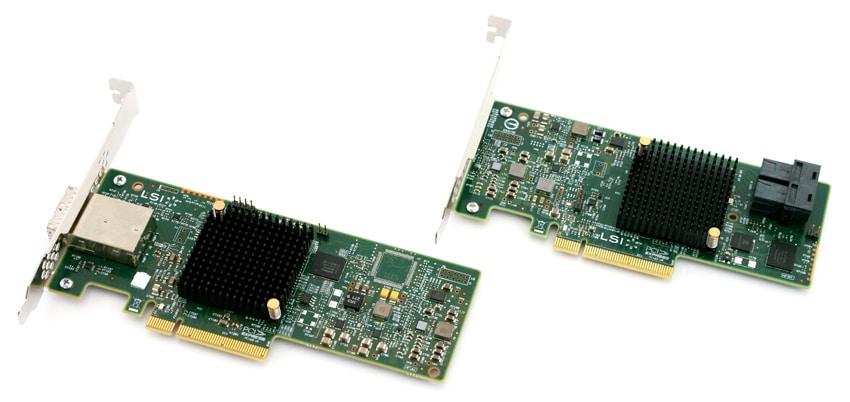
LSI's 9300 HBAS are based on the Fusion-MPT architected SAS controllers. This architecture uses LSI’s Fusion-MPT (Message Passing Technology), in which each controller features embedded PowerPC processors to boast maximum host CPU offload and allows LSI to publish a single binary OS driver to operate any Fusion-MPT controller or adapter. As a result, LSI indicates that it will enable high performance, reduced software development, and faster time to market.
For this review, we will be focusing on the LSI SAS 9300-8i and LSI SAS 9300-8e 12Gb/s SAS models, the latter offering 2×4 Mini-SAS HD SFF8643 external ports whereas the former has 2×4 Mini-SAS HD SFF8644 internal ports. As far as application goes, the 9300-8i supports both SAS and SATA drives and is specifically designed for users who need bandwidth for critical applications in 1U/2U servers and workstations. The 9300-8e HBAs are ideal in situations where applications require external storage connectivity, giving servers of any size the ability to attach over 1000 SAS or SATA end devices in external enclosures. It also has scale storage to support performance and capacity-intensive applications that use 12Gb/s SAS but also can support 6Gb/s SATA drives.
The LSI SAS 9300-8i and LSI SAS 9300-8e HBAs are available for a street price of $290 and $405 respectively and are backed by a 3-year warranty that includes free advanced technical support as well as an advanced replacement option.
LSI SAS 9300-8i/e Specifications
- Model: LSI SAS 9300-8i (LSI003450), LSI SAS 9300-8e (LSI00343)
- Physical Dimensions: Low profile (2.6” x 6.0”)
- Brackets: Full height and low profile vented
- Host Bus Type: x8 lane PCI Express® 3.0
- Internal Ports: 8
- Cable Support: Passive copper
- Data Transfer Rates: 12Gb/s SAS 3.0 compliant
- Devices Supported: 1024 Non-RAID SAS/SATA devices
- OS Support: Microsoft Windows, Linux (SuSE , Red Hat), Solaris, VMware , FreeBSD
- Fusion MPT Support: Fusion MPT™ 2.5
- I/O Controller: LSI SAS3008
- Internal Connectors (LSI SAS 9300-8i only): 2 Mini-SAS HD SFF8643
- External Connectors (LSI SAS 9300-8e only): 2 Mini-SAS HD SFF8644
- MTBF: >2,800,000 hours
- Operating Temperature: 0°C to 55°C
- Operating Humidity: 5% to 90% non-condensing
- Operating Voltage: +12V +/-8%; 3.3V +/-9%
- PCI Power: 13W, 14.5W
- Warranty: 3 years; free advanced technical support, advanced replacement option
Design and build
The LSI SAS 9300-8i has a very similar design as the Supermicro LSI SAS3008 HBA including its HHHL PCIe form-factor and port layout on the rear of the card. Additionally, as we mentioned above, it is equipped with the exact same controller as the Supermicro, the LSI SAS3008/Fusion MPT 2.5. The only significant differences are the different circuit board color as well as a slightly different port connector position.
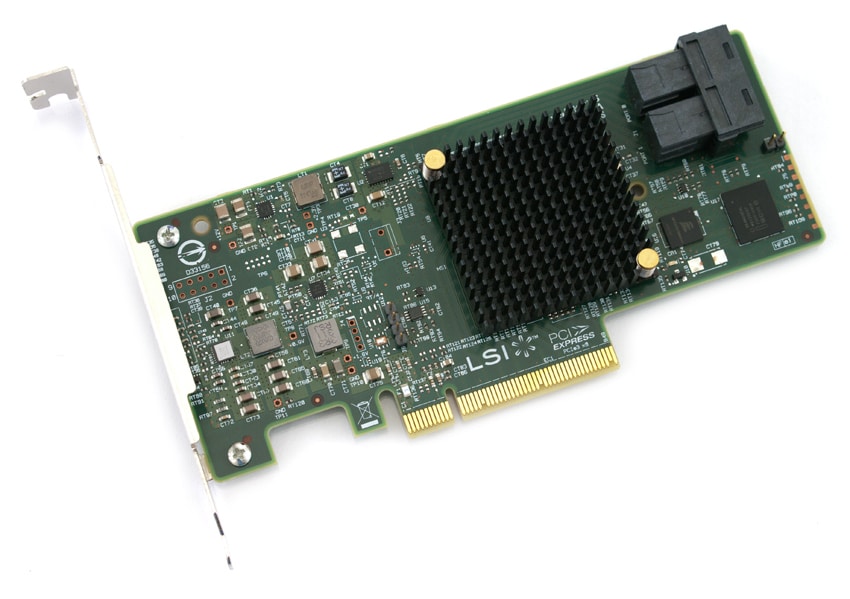
The LSI 12Gb/s SAS 9300 HBAs are a 6.6" × 2.7", low-profile board and can fit into 1U/2U rack-mounted servers as well as workstations with low-profile form factor.
At the heart of card is a good-sized heat sink covering the Fusion MPT 2.5 LSI SAS3008 I/O controller. Also visible is the x8 PCIe board edge connectors for its PCIe 3.0 interface.

Users can connect up to 1024 SAS and SATA devices with its 8 external and internal (the 9300-8e and 9300-8i respectively) 12Gb/s SAS and SATA ports as well as providing up to 12Gb/s SAS and up to 6Gb/s SATA performance across 8 lanes of PCIe 3.0 connectivity. One of the more important features are their 2 Mini-SAS HD (SFF8643 and SFF8644).
Application Workload Analysis
We tested the Supermicro LSI SAS3008 HBA with the following enterprise-class drives:
- HGST Ultrastar SSD800MM (400GB, Intel co-branded DB29AA11B0 controller, 25nm MLC NAND, 12Gb/s SAS)
- Toshiba PX02SM (400GB and 800GB units, Marvell co-branded TC58NC9036GTC controller, Toshiba 24nm eMLC NAND, 12Gb/s SAS)
- Toshiba PX02SS (400GB, Marvell co-branded TC58NC9036GTC controller, Toshiba 24nm eMLC NAND, 12Gb/s SAS)
- Toshiba PX03SN (800GB, Marvell TC58NC9036GTC co-branded controller, Toshiba 19nm MLC NAND, 12Gb/s SAS)
- Seagate 1200 (400GB, Marvell controller, 21nm Samsung eMLC NAND, 12Gb/s SAS)
To understand the performance characteristics of the listed enterprise storage devices (with the LSI HBA), it is vital to model the infrastructure and the application workloads found in live production environments. As such, our first benchmarks are comprised of the MySQL OLTP performance via SysBench and Microsoft SQL Server OLTP performance with a simulated TCP-C workload.
The Percona MySQL database test via SysBench measures the performance of OLTP activity with a group of Lenovo ThinkServer RD630s as database clients and the database environment stored on a single drive. We will be looking at the measures average TPS (Transactions Per Second) test for these drives. Though Percona and MariaDB use the Fusion-io flash-aware application APIs in the most recent releases of their databases, we will be testing each device in their legacy block-storage modes .
The LSI HBA allowed the Toshiba PX02SS boasts the best MySQL benchmark to date, with an impressive total IOPS of over 2,150. The PX03SN and SSD800MM are hot on its trail, taking second and third place respectively.
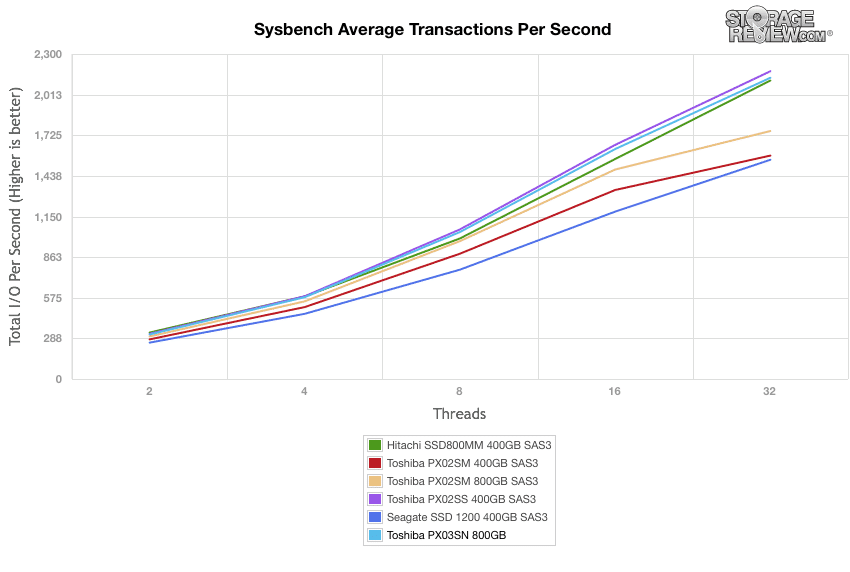
StorageReview’s Microsoft SQL Server OLTP testing protocol employs the current draft of the Transaction Processing Performance Council’s Benchmark C (TPC-C), an online transaction processing benchmark that simulates the activities found in complex application environments. The TPC-C benchmark comes closer than synthetic performance benchmarks to gauging the performance strengths and bottlenecks of storage infrastructure in database environments. Our SQL Server protocol uses a 685GB (3,000 scale) SQL Server database and measures the transactional performance and latency under a load of 30,000 virtual users.
Once again, the LSI HBA allowed for some great performance gains, with the Hitachi drive boasting an impressive 6,277.8TPS to take first place. The Toshiba PX02SN and PX03SN are close behind with 6,193.6TPS and 6,181.6TPS, respectively.
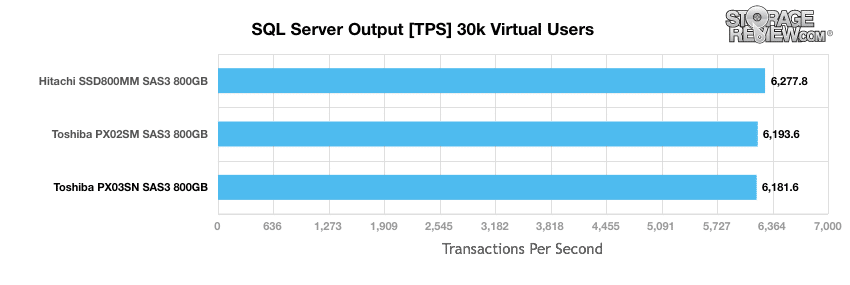
The average latencies during the SQL Server benchmark show a much bigger discrepancy when comparing the Hitachi and Toshiba drives with the PX03SN experiencing the highest average latency of the three at 111ms. These are still very good results.
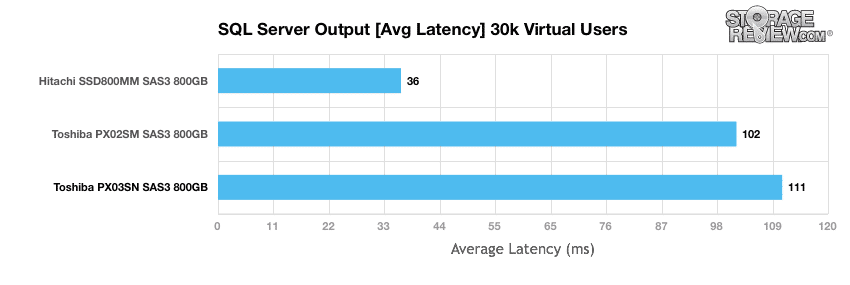
Moving to the enterprise synthetic workload analysis of the drives, more specifically our 4k 100% Read and 100% Write benchmark, most of the drives were able to boast some great numbers with the LSI HBA. The Hitachi SSD had the best read and write performance at 149,078IOPS and 66,367IOPS respectively.
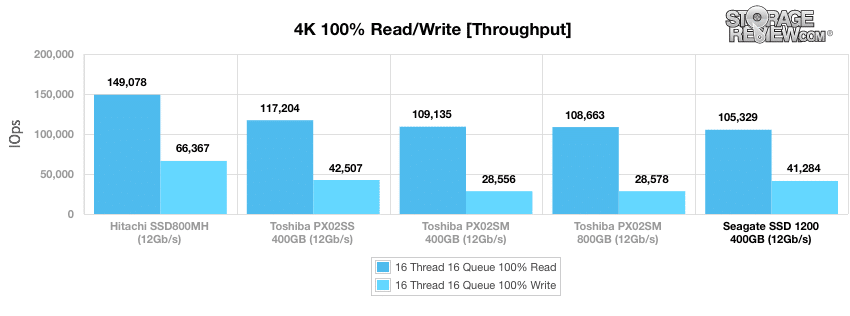
Conclusion
The LSI SAS 9300-8e/8i HBAs, like their brethren (LSI SAS3008 HBAs), proved to us they are very good performing products; they excelled at pretty much every test that was thrown at it. Both models support 8-lane (of PCIe 3.0) have include mini-SAS HD connectors to meet the SAS 3.0 standard allow servers of any size to attach 1024 SAS or SATA end devices in external/internal enclosures. Additionally, when attached to the right SSDs, these two LSI HBAs essentially remove the bottleneck of 6Gb/s SAS allowing businesses with even the most resource-heavy requirements to obtain their performance goals. This was quite evident in the above tested drives, as it allowed the SSDs to use their 12Gb/s potential, reaching a much higher performance level compared to SAS2, including very low latency and very high throughput. More specifically, the Toshiba PX02SS posted the best MySQL benchmark we have recorded to date, boasting over an impressive 2,150TPS across 32 threads; the PX03SN and SSD800MM showed very similar results and right up there with the PX02SS in performance.
Fortunately, these HBAs are available for purchase as an individual component, going for a reasonable price of $290 and $410 for the 9300-8i and 9300-8e respectively. The LSI HBAs set a bar for performance and reliability and are worth every penny, especially for those that are looking to attain the best possible results out of their next generation SAS3-based SSDs.
Pros
- Allows SAS3 SSDs perform at full potential
- Trusted platform with lengthy history
- Available for internal storage and external JBODs
Cons
- Only 8 SAS lanes native
Bottom Line
Continuing to make a good case for mainstream 12Gb/s SAS adoption in the enterprise sphere, the LSI SAS 9300-8e/8i HBAs have the ability to get the absolute best performance out of the next generation of SAS3-based SSDs.




 Amazon
Amazon